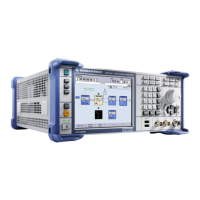Instrument Function
R&S
®
SMBV100A
247Operating Manual 1407.6062.32 ─ 08
Fig. 5-9: Definition of I/Q modulator in IS2000 and R&S Signal Generator f
According to IS2000, the RF signal s(t) is derived from the baseband I/Q signal as follows:
s(t)=i(t)cos(2pif
c
t)+q(t)sin(2pif
c
t)
The instrument family is based on the following definition:
s(t)=i(t)cos(2pif
c
t)-q(t)sin(2pif
c
t)
"I/Q Swap" must now be set to "On" so that an I/Q modulator defined according to IS2000
can cope with the RF signal generated by the R&S Signal Generator.
"Off"
I/Q control is normal.
"On"
The I and Q signals are swapped.
SCPI command:
[:SOURce<hw>]:IQ:SWAP[:STATe] on page 640
I/Q-Wideband - I/Q Mod
Optimized setting for wideband modulation signals (>5 MHz). Optimized setting for wide-
band modulation signals (>5 MHz).
The modulation frequency response is decreased at the expense of poorer harmonic
suppression. This is achieved by shifting the switching frequencies of the lowpass filters
in the output section.
SCPI command:
[:SOURce<hw>]:IQ:WBSTate on page 640
5.5.2.4 Analog Wideband I/Q Input
In the bottom section of the menu the crest factor is input for the external signal ("Analog
Wideband I/Q Input").
Crest Factor - I/Q Mod
(Analog Wideband I/Q Input only)
Sets the crest factor of the external analog signal.
I/Q Modulation - I/Q Mod Block

